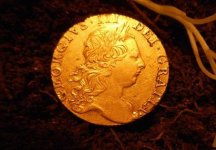I went out with Megalodon and Tommybuckets during the nor' easter today. We were on the beaches, two different ones, for about 5 hours. It was a tough go for sure. We were looking for shipwreck coins, modern jewelry, and coins.
It was a tough go! I found one British halfpenny, it was almost on top of the sand! Not the first time that had happened. A couple hours later I wandered semi close to the spot I found it and got a screamer of a signal. It read 88 on the Deus. I was puzzled as to the tone of the machine, as something around 88 is a lot of times a big wad of heavy aluminum. I got my scoop out and pounced.
In the scoop was what looked like a piece of flattened chewing gum. Like what? I got it out and saw some degradation to the metal, and determined it was made of copper. I thought at first it was perhaps a misshapen broken half cent, but it was too thick. Then I thought it was a piece to one of the WWII artillery shells that get found on the beach. After we got it to the truck, I turned the light of my cell on it and could finally see some writing, at least it looked like writing, and a depressed circle with a "VI" in it.
So...what we have is Spanish 6 Maravedis copper cob! This style is most likely from the era of Philip IV. Right now I can't move, almost 10 at night after driving 360 miles and walking miles on the beach...so...I can't tell or see what is on the coin. It will need some serious attention before it will be presentable. I don't know how much of the inscription is still there. The picture I have now just shows "dog food", essentially. I think with the light of day in the am and my optivisor and Andre's pencils, I'll see what she looks like in the am. And THEN both coins will need to be submerged in fresh water for numerous weeks, with water changes to try to get some of the salt out. Doing it right takes awhile.
And the other coin? A mere 1781 Hiberia half cent, George III. Obverse is nice. It apparently had been sitting with the obverse up as the salt water damage is primarily to the back of the coin. It has that great red coloration, and probably has been sitting high in the sand for over 200 years. The ones from down below generally tend to be either thin "razors" or heaving encrusted. This one apparently has been beach tumbled for a bit!
Pics tomorrow when I have enough light to get them. Back in about 1989 or so I found my first Revolutionary War cannon ball on a Friday 13!
It was a tough go! I found one British halfpenny, it was almost on top of the sand! Not the first time that had happened. A couple hours later I wandered semi close to the spot I found it and got a screamer of a signal. It read 88 on the Deus. I was puzzled as to the tone of the machine, as something around 88 is a lot of times a big wad of heavy aluminum. I got my scoop out and pounced.
In the scoop was what looked like a piece of flattened chewing gum. Like what? I got it out and saw some degradation to the metal, and determined it was made of copper. I thought at first it was perhaps a misshapen broken half cent, but it was too thick. Then I thought it was a piece to one of the WWII artillery shells that get found on the beach. After we got it to the truck, I turned the light of my cell on it and could finally see some writing, at least it looked like writing, and a depressed circle with a "VI" in it.
So...what we have is Spanish 6 Maravedis copper cob! This style is most likely from the era of Philip IV. Right now I can't move, almost 10 at night after driving 360 miles and walking miles on the beach...so...I can't tell or see what is on the coin. It will need some serious attention before it will be presentable. I don't know how much of the inscription is still there. The picture I have now just shows "dog food", essentially. I think with the light of day in the am and my optivisor and Andre's pencils, I'll see what she looks like in the am. And THEN both coins will need to be submerged in fresh water for numerous weeks, with water changes to try to get some of the salt out. Doing it right takes awhile.
And the other coin? A mere 1781 Hiberia half cent, George III. Obverse is nice. It apparently had been sitting with the obverse up as the salt water damage is primarily to the back of the coin. It has that great red coloration, and probably has been sitting high in the sand for over 200 years. The ones from down below generally tend to be either thin "razors" or heaving encrusted. This one apparently has been beach tumbled for a bit!
Pics tomorrow when I have enough light to get them. Back in about 1989 or so I found my first Revolutionary War cannon ball on a Friday 13!
Amazon Forum Fav 👍
Upvote
34











